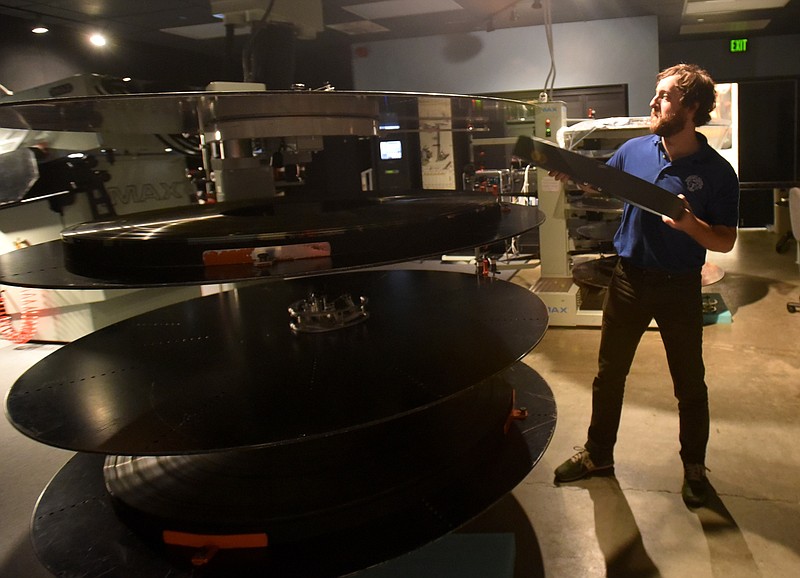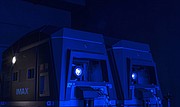What’s playing?
[IMAX tickets are $9.95 adults, $8.50 ages 3-12, free to ages 3 and under; combo tickets with aquarium admittance are $35.95/$24.95.]* Today: “Jerusalem 3D” (noon/2 p.m./4 p.m.), “Humpback Whales 3D” (1 p.m./3 p.m.)* Monday: “Jerusalem 3D” (noon/2 p.m./4 p.m.), “Humpback Whales 3D” (1 p.m./3 p.m.)* Tuesday: “Jerusalem 3D” (noon/2 p.m./4 p.m.), “Humpback Whales 3D” (1 p.m./3 p.m.)* Wednesday: “Jerusalem 3D” (noon/2 p.m./4 p.m.), “Humpback Whales 3D” (1 p.m./3 p.m.)* Thursday: “The Polar Express” (noon/2 p.m./4 p.m.)* Friday: Closed for Christmas* Saturday: “Jerusalem 3D” (noon/2 p.m./4 p.m.), “Humpback Whales 3D” (1 p.m./3 p.m.)
Videos explaining IMAX technology
* Watch a featurette explaining the development and benefits of IMAX laser technology at https://www.youtube.com/watch?v=tegPejMAoaE&feature=youtu.be* Watch a video shot by aquarium spokesperson Thom Benson from inside the IMAX projection booth at https://www.youtube.com/watch?v=e4puGpvTWUo
Other locations with IMAX digital laser projection
In the United States* TCL Chinese Theatres IMAX – Hollywood, CA* AMC Metreon 16 & IMAX – San Francisco, CA* AMC Universal CityWalk Stadium 19 & IMAX – Universal City, CA* Sunbrella IMAX 3D Theatre, Jordan’s Furniture Reading – Reading, MA* Scotiabank Toronto & IMAX – Toronto, Canada* Airbus IMAX, Stephen F. Udvar-Hazy Center – Chantilly, VA* Boeing IMAX and the Pacific Science Center – Seattle, WAAbroad* IMAX, Melbourne Museum – Australia* Event Cinemas Queen Street IMAX – New Zealand* VOX Cinemas & IMAX – UAE* Cinestar Berlin & IMAX – Germany* Filmpalast AM ZKM IMAX – Germany* Empire Leicester Square IMAX – U.K.* Cineworld Sheffield & IMAX – U.K.
On Jan. 4, the 89-by-66-foot screen at the Tennessee Aquarium IMAX Center will temporarily darken as it undergoes an equally enormous technological upgrade.
When the doors reopen in February, the theater will be equipped with a pair of IMAX's cutting-edge digital laser projectors. The new system replaces a 19-year-old, 70-millimeter film projector - one of the last such projectors in the area - and is so new it's currently installed in just seven theaters in the U.S. and seven more internationally.
But more than its rarity, the system offers a visual improvement over film that is more than worth the $1 million it will cost to install, says Don Walker, the aquarium's director of guest services and one of a handful of aquarium employees who helped evaluate the new technology at other facilities.
"You'll see colors you can't hardly imagine," Walker says. "Going to laser digital, we are leapfrogging way above where we are today. The images are very sharp and clear. It really helps to tell the story."
The aquarium's IMAX Center is overdue for an upgrade. Other than changing seats and adding a digital audio system several years ago, it hasn't been updated since opening in 1996, says Gordon Stalans, the aquarium's director of finance and chairman of the board for the international Giant Screen Cinema Association.
"Over nearly 20 years, there have been technology improvements in the industry, including the transition to digital-projection technology," Stalans says. "We have known for several years that film is going away. The advent of laser digital projection has allowed us to update to a technology that we feel is even better."
Space-age specs
To hear IMAX executives describe it, the new system's features might as well have been cribbed from an episode of "Star Trek":
- Dual 4K laser projectors.
- A patented "free space light engine."
- Sub-pixel alignment.
- Remote monitored image and audio calibration.
Laser digital technology has been in active development for about 2 1/2 years and is a complete overhaul of previous approaches to digital projection, which were plagued by dim images, poor contrast and a lack of sharpness, says IMAX Chief Technology Officer Brian Bonnick.
"Looking at laser opened the doors to getting more brightness because it's a more concentrated beam," Bonnick says from IMAX headquarters in Toronto. "We decided that, if we're going to implement a laser system, we really should re-architecture the projector around the benefits that laser can bring to the equation. That meant a ground-up development."
Many of digital projection's failings, Bonnick says, are the result of a continued reliance on using a glass prism to split white light into red, green and blue, then feed them into a trio of chips that then direct the light onto the screen. Especially when displaying 3D films, this process results in a lot of light loss and a correspondingly dim image.
Because different parts of the projector heat up (expand) and cool down (contract) at different rates, they can move out of alignment, resulting in warping and color imperfections, Bonnick says.
So when they cleared the drawing board to start work on a new approach to projection, IMAX technicians threw out the prism. The new system generates an image using a trio of red, green and blue lasers that project colored light directly onto chips mounted farther apart on a frame made of invar, an alloy which Bonnick describes as "the most thermally stable material on the planet."
"Now I have three chips all expanding and contracting in parallel with each other, which means pixels on the screen are perfectly aligned," he says. "By getting rid of the prism and separating the chips farther, I have no stray light to deal with, and my inter-frame contrast goes through the roof."
IMAX began rolling out laser projection about six months ago. To date, the technology is installed in 14 theaters - the next closest to Chattanooga is more than 500 miles away at the Smithsonian National Air and Space Museum in Washington, D.C. - but Bonnick says there are an additional 70 theaters have signed on to upgrade to laser projectors.
While closed for the install, the aquarium also will update its audio system to meet the 12-channel standard supported by the new IMAX projectors. The changeover will double the current crop of speakers, including four channels mounted to the ceiling to simulate effects such as a jet flyover or divers passing underneath a humpback whale.
Both the audio and visual quality of the new system will be monitored remotely by IMAX at facilities in Canada and China. Using a camera and microphones that will be installed in the Chattanooga theater, IMAX technicians will be able to assess the quality of the sound and image and make adjustments to ensure optimum performance, Bonnick says.
"As an example, we're able to guarantee our brightness levels. We [can ensure] that each projector is identical to the next. That's critical for 3-D because if one is less [bright] than the other, your brain picks that up," he says.
Photo Gallery
Downtown IMAX about to install laser projection technology used in fewer than 15 theaters worldwide
"We're in touch with every digital projector out there, making sure it is performing as best it can be. Because of that system, we have an over 92 percent response remotely in solving any problems people have."
'A game-changer'
Aquarium officials began debating an upgrade to digital projection about four years ago. A group of its employees, including Stalans and Walker, traveled the country to see demos of earlier versions of the technology. None offered an experience that surpassed the image quality and brightness of traditional, 70mm IMAX film, they say, especially when projected on a screen as large as the one at the aquarium.
But when aquarium chief projectionist Corey Cobb saw laser digital for the first time in the Pacific Science Center's IMAX in Seattle, he says he knew the search was over.
"When I saw the demos, it was done on a screen that's almost as big as this one an 80-[foot]-by-60-[foot] screen. It's unbelievable - zero pixels are visible," he says one morning while prepping films in the aquarium's projection booth, which is located dozens of feet above the auditorium floor. "Even stuff I've seen on smaller screens couldn't compare to this."
As he talks, Cobb deftly navigates the darkened booth, where two of the day's titles, "The Polar Express 3D" and "Humpback Whales 3D," unspool in a convoluted, skin-nicking maze of plastic ribbons feeding into the pair of film projectors. When running, the rapid-fire clacking of the projector and the whirring of the spinning reels creates an almost overwhelming din that makes conversation next to impossible.
The aquarium's chief projectionist for the last nine years, Cobb's job often involves the laborious task of piecing films together from separate reels that arrive in metal cases as large as a third grader is tall. Properly preparing a new title on film can take as long as 15 hours, he says, and results in a master reel measuring 4 1/2 feet across and so heavy it must be moved with a forklift.
The reliance on an outdated format and the time it takes to prepare each title has long limited the kinds of content the aquarium could show. IMAX film offerings are few and far between, and reels cost between $25,000 and $30,000, Stalans says. After the upgrade to laser projection, titles will arrive on hard drives called Digital Cinema Packages that are significantly smaller and less expensive to screen - not to mention quieter, thanks to a lack of moving parts in the new projectors, Cobb adds.
"With digital technology, we will receive each film we want to show at a fraction of the cost we were paying for a film print," Stalans says. "Although we still will not be changing films as often as conventional cinemas do, the digital system will give us more flexibility in our programming choices."
The new system also will be able to take advantage of connecting to Chattanooga's Gig system, opening up opportunities for special events such as streaming live sporting events or letting school groups interact via a remote video feed with scientists around the world.
Because of the many improvements it promises to bring to the theater, Walker says he's confident that guests won't feel nostalgic for the passing of film - if they even realized it was still in use.
"The technology we're moving toward is cutting-edge; [it's] so new," he laughs. "Basically, complaints might be made if we convert to laser and then back to film. After they see laser, they won't want to see film at all."
Contact Casey Phillips at cphillips@timesfree press.com or 423-757-6205. Follow him on Twitter at @PhillipsCTFP.

